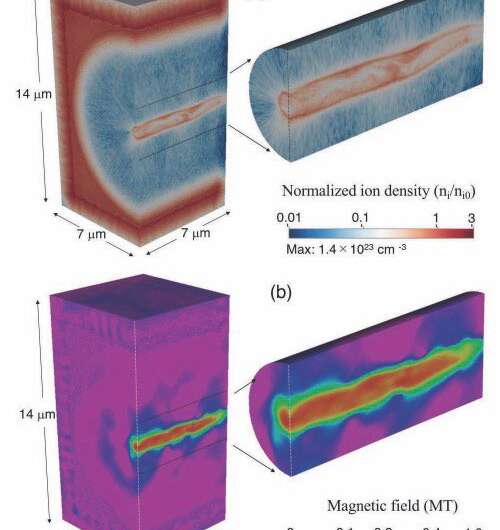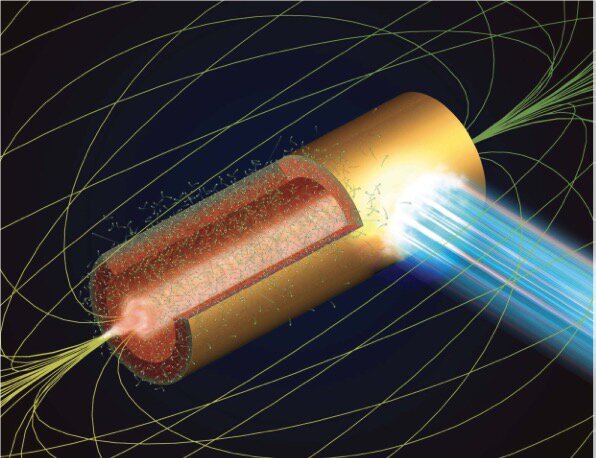Recently, a research team at Osaka University has successfully demonstrated the generation of megatesla (MT)-order magnetic fields via three-dimensional particle simulations on laser-matter interaction. The strength of MT magnetic fields is 1–10 billion times stronger than geomagnetism (0.3–0.5 G), and these fields are expected to be observed only in the close vicinity of celestial bodies such as neutron stars or black holes. This result should facilitate an ambitious experiment to achieve MT-order magnetic fields in the laboratory, which is now in progress.
Since the 19th century, scientists have strived to achieve the highest magnetic fields in the laboratory. To date, the highest magnetic field observed in the laboratory is in the kilotesla (kT)-order. In 2020, Masakatsu Murakami at Osaka University proposed a novel scheme called microtube implosions (MTI) to generate ultrahigh magnetic fields on the MT-order. Irradiating a micron-sized hollow cylinder with ultraintense and ultrashort laser pulses generates hot electrons with velocities close to the speed of light. Those hot electrons launch a cylindrically symmetric implosion of the inner wall ions towards the central axis. An applied pre-seeded magnetic field of the kilotesla-order, parallel to the central axis, bends the trajectories of ions and electrons in opposite directions because of the Lorentz force. Near the target axis, those bent trajectories of ions and electrons collectively form a strong spin current that generates MT-order magnetic fields.
In this study, one of the team members, Didar Shokov, has extensively conducted three-dimensional simulations using the supercomputer OCTOPUS at Osaka University’s Cybermedia Center. As a result, a distinct scaling law has been found relating the performance of the generation of the magnetic fields by MTI and such external parameters as applied laser intensity, laser energy, and target size.

Figure2. Perspective views of the normalized ion density ni/ni0 and the z-component of the magnetic field Bz, respectively, observed at t∼200 fs, which is obtained by a 3D EPOCH simulation. A cubic aluminum target with a size of 14 μm × 14 μm × 14 μm is set at the center, which has a cylindrical cavity with a radius of R0 = 5 μm and an axis overlapping the z-axis. The seed magnetic field B0 = 6 kT parallel to the z-axis is uniformly set over the entire domain. The four faces of the target parallel to the z-axis are normally irradiated by uniform laser pulses simultaneously, which are characterized by λL = 0.8 μm, IL =3×1021 Wcm−2 and τL =50fs. © Masakatsu Murakami et al., High Power Laser Science and Engineering
“Our simulation showed that ultrahigh megatesla magnetic fields, which were thought to be impossible to realize on earth, can be achieved using today’s laser technology. The scaling law and detailed temporal behavior of the magnetic fields in the target are expected to facilitate laboratory experiments using the Peta-watt laser system ‘LFEX’ at Osaka University’s Institute of Laser Engineering, which are now in progress,” Murakami says.
More information:
D. Shokov et al, Laser scaling for generation of megatesla magnetic fields by microtube implosions, High Power Laser Science and Engineering (2021). DOI: 10.1017/hpl.2021.46
Citation:
Toward achieving megatesla magnetic fields in the laboratory (2021, December 9)



